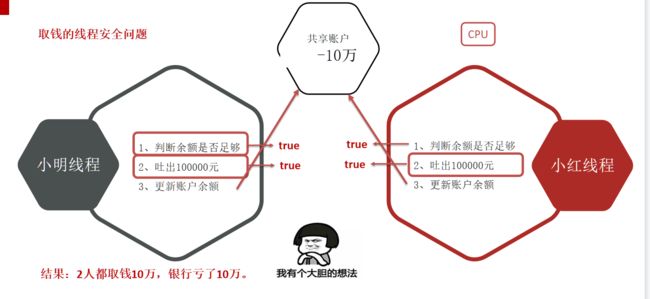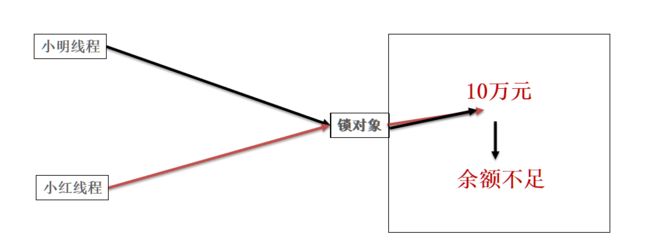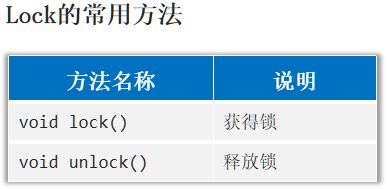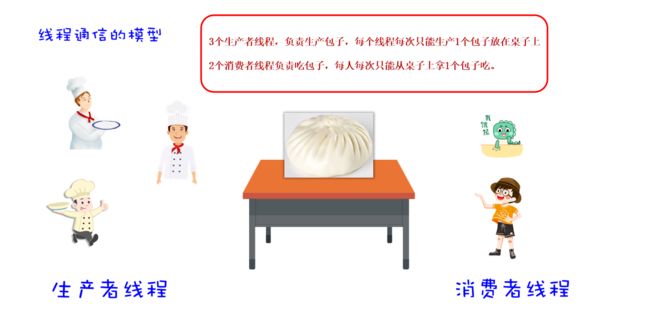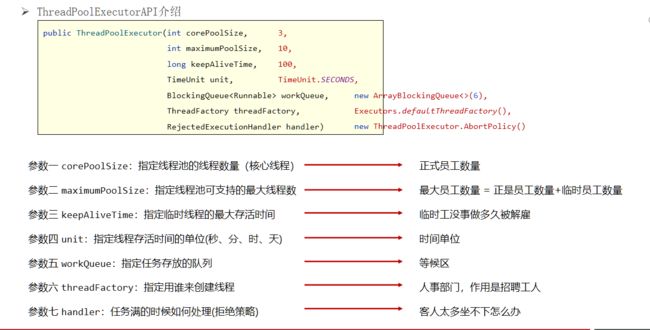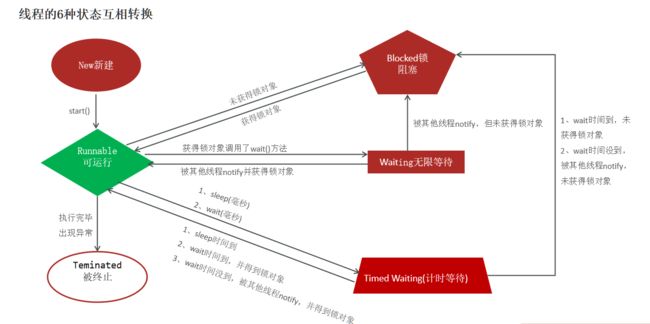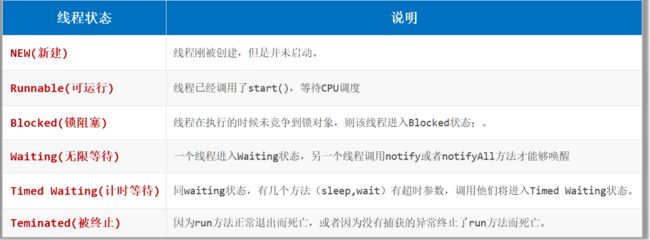多线程和线程池相关概念和线程方法的使用
1. 什么是线程(线程的概念)
线程的概念:线程其实是程序中的一条执行路径。
2. 多线程的创建
2.1. 多线程的创建方式一:继承Thread类
- 步骤:1、定义一个子类MyThread继承线程类java.lang.Thread,重写run()方法
2、创建MyThread类的对象
3、调用线程对象的start()方法启动线程(启动后还是执行run方法的)
- 注意事项:1、启动线程必须是调用start方法,不是调用run方法。
2、不要把主线程任务放在启动子线程之前。
直接调用run方法会当成普通方法执行,此时相当于还是单线程执行。
只有调用start方法才是启动一个新的线程执行。
这样主线程一直是先跑完的,相当于是一个单线程的效果了。
- 优缺点:
-
- 优点:编码简单
- 缺点:存在单继承的局限性,线程类继承Thread后,不能继承其他类,不便于扩展。
public class MyThread extends Thread{
// 2、必须重写Thread类的run方法
@Override
public void run() {
// 描述线程的执行任务。
for (int i = 1; i <= 5; i++) {
System.out.println("子线程MyThread输出:" + i);
}
}
}
//测试类
public class ThreadTest1 {
// main方法是由一条默认的主线程负责执行。
public static void main(String[] args) {
// 3、创建MyThread线程类的对象代表一个线程
Thread t = new MyThread();
// 4、启动线程(自动执行run方法的)
t.start();
for (int i = 1; i <= 5; i++) {
System.out.println("主线程main输出:" + i);
}
}
}2.2. 多线程的创建方式二:实现Runnable接口
- 步骤
-
- 定义一个线程任务类MyRunnable实现Runnable接口,重写run()方法
- 创建MyRunnable任务对象
- 把MyRunnable任务对象交给Thread处理。
|
|
|
|
-
- 调用线程对象的start()方法启动线程
- 优缺点
-
- 优点:任务类只是实现接口,可以继续继承其他类、实现其他接口,扩展性强。
- 缺点:需要多一个Runnable对象。
/**
* 1、定义一个任务类,实现Runnable接口
*/
public class MyRunnable implements Runnable{
// 2、重写runnable的run方法
@Override
public void run() {
// 线程要执行的任务。
for (int i = 1; i <= 5; i++) {
System.out.println("子线程输出 ===》" + i);
}
}
}
public class ThreadTest2 {
public static void main(String[] args) {
// 3、创建任务对象。
Runnable target = new MyRunnable();
// 4、把任务对象交给一个线程对象处理。
// public Thread(Runnable target)
new Thread(target).start();
for (int i = 1; i <= 5; i++) {
System.out.println("主线程main输出 ===》" + i);
}
}
}- 匿名内部类创建线程
public class ThreadTest2_2 {
public static void main(String[] args) {
// 1、直接创建Runnable接口的匿名内部类形式(任务对象)
Runnable target = new Runnable() {
@Override
public void run() {
for (int i = 1; i <= 5; i++) {
System.out.println("子线程1输出:" + i);
}
}
};
new Thread(target).start();
// 简化形式1:
new Thread(new Runnable() {
@Override
public void run() {
for (int i = 1; i <= 5; i++) {
System.out.println("子线程2输出:" + i);
}
}
}).start();
// 简化形式2:
new Thread(() -> {
for (int i = 1; i <= 5; i++) {
System.out.println("子线程3输出:" + i);
}
}).start();
for (int i = 1; i <= 5; i++) {
System.out.println("主线程main输出:" + i);
}
}
}2.3. 多线程的第三种创建方式:利用Callable接口、FutureTask类来实现。
- 步骤
- 创建任务对象
-
- 定义一个类实现Callable接口,重写call方法,封装要做的事情,和要返回的数据。
- 把Callable类型的对象封装成FutureTask(线程任务对象)。
- 把线程任务对象交给Thread对象。
- 调用Thread对象的start方法启动线程。
- 线程执行完毕后、通过FutureTask对象的的get方法去获取线程任务执行的结果。
- 优缺点
- 优点:线程任务类只是实现接口,可以继续继承类和实现接口,扩展性强;可以在线程执行完毕后去获取线程执行的结果。
- 缺点:编码复杂一点。
/**
* 1、让子类继承Thread线程类。
*/
public class MyThread extends Thread{
// 2、必须重写Thread类的run方法
@Override
public void run() {
// 描述线程的执行任务。
for (int i = 1; i <= 5; i++) {
System.out.println("子线程MyThread输出:" + i);
}
}
}
public class ThreadTest3 {
public static void main(String[] args) throws Exception {
// 3、创建一个Callable的对象
Callable call = new MyCallable(100);
// 4、把Callable的对象封装成一个FutureTask对象(任务对象)
// 未来任务对象的作用?
// 1、是一个任务对象,实现了Runnable对象.
// 2、可以在线程执行完毕之后,用未来任务对象调用get方法获取线程执行完毕后的结果。
FutureTask f1 = new FutureTask<>(call);
// 5、把任务对象交给一个Thread对象
new Thread(f1).start();
Callable call2 = new MyCallable(200);
FutureTask f2 = new FutureTask<>(call2);
new Thread(f2).start();
// 6、获取线程执行完毕后返回的结果。
// 注意:如果执行到这儿,假如上面的线程还没有执行完毕
// 这里的代码会暂停,等待上面线程执行完毕后才会获取结果。
String rs = f1.get();
System.out.println(rs);
String rs2 = f2.get();
System.out.println(rs2);
}
} 3. Thread的常用方法
- 演示
public class MyThread extends Thread{
public MyThread(String name){
super(name); //1.执行父类Thread(String name)构造器,为当前线程设置名字了
}
@Override
public void run() {
//2.currentThread() 哪个线程执行它,它就会得到哪个线程对象。
Thread t = Thread.currentThread();
for (int i = 1; i <= 3; i++) {
//3.getName() 获取线程名称
System.out.println(t.getName() + "输出:" + i);
}
}
}
//测试类
public class ThreadTest1 {
public static void main(String[] args) {
Thread t1 = new MyThread();
t1.setName(String name) //设置线程名称;
t1.start();
System.out.println(t1.getName()); //Thread-0
Thread t2 = new MyThread("2号线程");
// t2.setName("2号线程");
t2.start();
System.out.println(t2.getName()); // Thread-1
// 主线程对象的名字
// 哪个线程执行它,它就会得到哪个线程对象。
Thread m = Thread.currentThread();
m.setName("最牛的线程");
System.out.println(m.getName()); // main
for (int i = 1; i <= 5; i++) {
System.out.println(m.getName() + "线程输出:" + i);
}
}
}
//join方法演示
public class ThreadTest2 {
public static void main(String[] args) throws Exception {
// join方法作用:让当前调用这个方法的线程先执行完。
Thread t1 = new MyThread("1号线程");
t1.start();
t1.join();
Thread t2 = new MyThread("2号线程");
t2.start();
t2.join();
Thread t3 = new MyThread("3号线程");
t3.start();
t3.join();
}
}4. 线程安全
- 什么是线程安全问题
多个线程,同时操作同一个共享资源的时候,可能会出现业务安全问题。
- 下面通过一个取钱的案例给同学们演示一下。案例需求如下
场景:小明和小红是一对夫妻,他们有一个共享账户,余额是10万元,小红和小明同时来取钱,并且2人各自都在取钱10万元,可能出现什么问题呢?如下图所示,小明和小红假设都是一个线程,本类每个线程都应该执行完三步操作,才算是完成的取钱的操作。但是真实执行过程可能是下面这样子的
① 小红线程只执行了判断余额是否足够(条件为true),然后CPU的执行权就被小红线程抢走了。
② 小红线程也执行了判断了余额是否足够(条件也是true), 然后CPU执行权又被小明线程抢走了。
③ 小明线程由于刚才已经判断余额是否足够了,直接执行第2步,吐出了10万元钱,此时共享账户月为0。然后CPU执行权又被小红线程抢走。
④ 小红线程由于刚刚也已经判断余额是否足够了,直接执行第2步,吐出了10万元钱,此时共享账户月为-10万。
线程安全代码演示:
1.先创建一个共享账户类
public class Account {
private String cardId; // 卡号
private double money; // 余额。
public Account() {
}
public Account(String cardId, double money) {
this.cardId = cardId;
this.money = money;
}
// 小明 小红同时过来的
public void drawMoney(double money) {
// 先搞清楚是谁来取钱?
String name = Thread.currentThread().getName();
// 1、判断余额是否足够
if(this.money >= money){
System.out.println(name + "来取钱" + money + "成功!");
this.money -= money;
System.out.println(name + "来取钱后,余额剩余:" + this.money);
}else {
System.out.println(name + "来取钱:余额不足~");
}
}
public String getCardId() {
return cardId;
}
public void setCardId(String cardId) {
this.cardId = cardId;
}
public double getMoney() {
return money;
}
public void setMoney(double money) {
this.money = money;
}
}2.在定义一个是取钱的线程类
public class DrawThread extends Thread{
private Account acc;
public DrawThread(Account acc, String name){
super(name);
this.acc = acc;
}
@Override
public void run() {
// 取钱(小明,小红)
acc.drawMoney(100000);
}
}3.最后,再写一个测试类,在测试类中创建两个线程对象
public class ThreadTest {
public static void main(String[] args) {
// 1、创建一个账户对象,代表两个人的共享账户。
Account acc = new Account("ICBC-110", 100000);
// 2、创建两个线程,分别代表小明 小红,再去同一个账户对象中取钱10万。
new DrawThread(acc, "小明").start(); // 小明
new DrawThread(acc, "小红").start(); // 小红
}
}结果如图所示:
总结:线程出现安全问题的的原因是
1.存在多个线程在同时执行
2.同时访问一个共享资源
3.存在修改该共享资源
5. 线程同步
5.1. 认识线程同步
- 线程同步就是解决线程安全问题的方案
- 线程同步的思想
-
- 让多个线程实现先后依次访问共享资源,这样就解决了安全问题。
线程同步常见方案
- 加锁:每次只允许一个线程加锁,加锁后才能进入访问,访问完毕后自动解锁,然后其他线程才能再加锁进来。
5.2. 方式一,同步代码块
- 同步代码块
- 作用:把访问共享资源的核心代码给上锁,以此保证线程安全。
synchronized(同步锁) {
访问共享资源的核心代码
}- 原理:每次只允许一个线程加锁后进入,执行完毕后自动解锁,其他线程才可以进来执行。
- 同步锁的注意事项:对于当前同时执行的线程来说,同步锁必须是同一把(同一个对象),否则会出bug。
// 小明 小红线程同时过来的
public void drawMoney(double money) {
// 先搞清楚是谁来取钱?
String name = Thread.currentThread().getName();
// 1、判断余额是否足够
// this正好代表共享资源!
synchronized (this) {
if(this.money >= money){
System.out.println(name + "来取钱" + money + "成功!");
this.money -= money;
System.out.println(name + "来取钱后,余额剩余:" + this.money);
}else {
System.out.println(name + "来取钱:余额不足~");
}
}
}锁对象的使用规范
- 建议使用共享资源作为锁对象,对于实例方法建议使用this作为锁对象。
- 对于静态方法建议使用字节码(类名.class)对象作为锁对象。
5.3. 方式二,同步方法
其实同步方法,就是把整个方法给锁住,一个线程调用这个方法,另一个线程调用的时候就执行不了,只有等上一个线程调用结束,下一个线程调用才能继续执行。
- 同步方法底层原理:
1.同步方法其实底层也是有隐式锁对象的,只是锁的范围是整个方法代码。
2.如果方法是实例方法:同步方法默认用this作为的锁对象。
3.如果方法是静态方法:同步方法默认用类名.class作为的锁对象。
// 同步方法
public synchronized void drawMoney(double money) {
// 先搞清楚是谁来取钱?
String name = Thread.currentThread().getName();
// 1、判断余额是否足够
if(this.money >= money){
System.out.println(name + "来取钱" + money + "成功!");
this.money -= money;
System.out.println(name + "来取钱后,余额剩余:" + this.money);
}else {
System.out.println(name + "来取钱:余额不足~");
}
}问题:是同步代码块好还是同步方法好一点?
- 范围上:同步代码块锁的范围更小,同步方法锁的范围更大。
- 可读性:同步方法更好。
5.4. 方式三,Lock锁
Lock锁
- Lock锁是JDK5开始提供的一个新的锁定操作,通过它可以创建出锁对象进行加锁和解锁,更灵活、更方便、更强大。
- Lock是接口,不能直接实例化,可以采用它的实现类ReentrantLock来构建Lock锁对象。
1.首先在成员变量位子,需要创建一个Lock接口的实现类对象(这个对象就是锁对象)
private final Lock lk = new ReentrantLock();
2.在需要上锁的地方加入下面的代码
lk.lock(); // 加锁
//...中间是被锁住的代码...
lk.unlock(); // 解锁
// 创建了一个锁对象
private final Lock lk = new ReentrantLock();
public void drawMoney(double money) {
// 先搞清楚是谁来取钱?
String name = Thread.currentThread().getName();
try {
lk.lock(); // 加锁
// 1、判断余额是否足够
if(this.money >= money){
System.out.println(name + "来取钱" + money + "成功!");
this.money -= money;
System.out.println(name + "来取钱后,余额剩余:" + this.money);
}else {
System.out.println(name + "来取钱:余额不足~");
}
} catch (Exception e) {
e.printStackTrace();
} finally {
lk.unlock(); // 解锁
}
}
}6. 线程通信
- 线程通信:当多个线程共同操作共享的资源时,线程间通过某种方式互相告知自己的状态,以相互协调,并避免无效的资源争夺。
线程通信的常见模型(生产者与消费者模型)
- 生产者线程负责生产数据
- 消费者线程负责消费生产者生产的数据。
- 注意:生产者生产完数据应该等待自己,通知消费者消费;消费者消费完数据也应该等待自己,再通知生产者生产!
线程通信常用的三个方法:
案例:有3个厨师(生产者线程),两个顾客(消费者线程)
案例思路分析:
1.先确定在这个案例中,什么是共享数据?
答:这里案例中桌子是共享数据,因为厨师和顾客都需要对桌子上的包子进行操作。
2.再确定有那几条线程?哪个是生产者,哪个是消费者?
答:厨师是生产者线程,3条生产者线程;
顾客是消费者线程,2条消费者线程
3.什么时候将哪一个线程设置为什么状态
生产者线程(厨师)放包子:
(1)先判断是否有包子
(2)没有包子时,厨师开始做包子, 做完之后把别人唤醒,然后让自己等待
(3)有包子时,不做包子了,直接唤醒别人、然后让自己等待
消费者线程(顾客)吃包子:
(1)先判断是否有包子
(2)有包子时,顾客开始吃包子, 吃完之后把别人唤醒,然后让自己等待
(3)没有包子时,不吃包子了,直接唤醒别人、然后让自己等待
创建一个桌子类:
public class Desk {
private List list = new ArrayList<>();
// 放1个包子的方法
// 厨师1 厨师2 厨师3
public synchronized void put() {
try {
String name = Thread.currentThread().getName();
// 判断是否有包子。
if(list.size() == 0){
list.add(name + "做的肉包子");
System.out.println(name + "做了一个肉包子~~");
Thread.sleep(2000);
// 唤醒别人, 等待自己
this.notifyAll();
this.wait();
}else {
// 有包子了,不做了。
// 唤醒别人, 等待自己
this.notifyAll();
this.wait();
}
} catch (Exception e) {
e.printStackTrace();
}
}
// 吃货1 吃货2
public synchronized void get() {
try {
String name = Thread.currentThread().getName();
if(list.size() == 1){
// 有包子,吃了
System.out.println(name + "吃了:" + list.get(0));
list.clear();
Thread.sleep(1000);
this.notifyAll();
this.wait();
}else {
// 没有包子
this.notifyAll();
this.wait();
}
} catch (Exception e) {
e.printStackTrace();
}
}
} 再写测试类,在测试类中,创建3个厨师线程对象,再创建2个顾客对象,并启动所有线程:
public class ThreadTest {
public static void main(String[] args) {
// 需求:3个生产者线程,负责生产包子,每个线程每次只能生产1个包子放在桌子上
// 2个消费者线程负责吃包子,每人每次只能从桌子上拿1个包子吃。
Desk desk = new Desk();
// 创建3个生产者线程(3个厨师)
new Thread(() -> {
while (true) {
desk.put();
}
}, "厨师1").start();
new Thread(() -> {
while (true) {
desk.put();
}
}, "厨师2").start();
new Thread(() -> {
while (true) {
desk.put();
}
}, "厨师3").start();
// 创建2个消费者线程(2个吃货)
new Thread(() -> {
while (true) {
desk.get();
}
}, "吃货1").start();
new Thread(() -> {
while (true) {
desk.get();
}
}, "吃货2").start();
}
}结果:你会发现多个线程相互协调执行,避免无效的资源挣抢。
7. 线程池
线程池是一个容器,可以保存一些长久存活的线程对象,负责创建、复用、管理线程
线程池的优势
1.降低资源消耗,重复利用线程池中线程,不需要每次都创建、销毁 。
2.便于线程管理,线程池可以集中管理并发线程的数量。
7.1. 线程池的使用方式1-提交Runnable任务
- Executors工具类创建线程池
- JDK 1.5起提供了线程池,Executors类是线程池的工具类,通过Executors工具类可以创建线程池。
- ExecutorService:真正的代表线程池的接口。常见实现类ThreadPoolExecutor
ExecutorService pool = new ThreadPoolExecutor( //7个参数
3, //核心线程数有3个
5, //最大线程数有5个。 临时线程数=最大线程数-核心线程数=5-3=2
8, //临时线程存活的时间8秒。 意思是临时线程8秒没有任务执行,就会被销毁掉。
TimeUnit.SECONDS,//时间单位(秒)
new ArrayBlockingQueue<>(4), //任务阻塞队列,没有来得及执行的任务在,任务队列中等待
Executors.defaultThreadFactory(), //用于创建线程的工厂对象
new ThreadPoolExecutor.CallerRunsPolicy() //拒绝策略
);关于线程池,我们需要注意下面的两个问题:
- 临时线程什么时候创建?
-
- 新任务提交时,发现核心线程都在忙、任务队列满了、并且还可以创建临时线程,此时会创建临时线程。
- 什么时候开始拒绝新的任务?
-
- 核心线程和临时线程都在忙、任务队列也满了、新任务过来时才会开始拒绝任务。
- 核心线程和临时线程都在忙、任务队列也满了、新任务过来时才会开始拒绝任务。
- ExecutorService线程池中的常用方法
创建一个线程任务类
public class MyRunnable implements Runnable{
@Override
public void run() {
// 任务是干啥的?
System.out.println(Thread.currentThread().getName() + " ==> 输出666~~");
//为了模拟线程一直在执行,这里睡久一点
try {
Thread.sleep(Integer.MAX_VALUE);
} catch (InterruptedException e) {
e.printStackTrace();
}
}
}执行Runnable任务的代码
ExecutorService pool = new ThreadPoolExecutor(
3, //核心线程数有3个
5, //最大线程数有5个。 临时线程数=最大线程数-核心线程数=5-3=2
8, //临时线程存活的时间8秒。 意思是临时线程8秒没有任务执行,就会被销毁掉。
TimeUnit.SECONDS,//时间单位(秒)
new ArrayBlockingQueue<>(4), //任务阻塞队列,没有来得及执行的任务在,任务队列中等待
Executors.defaultThreadFactory(), //用于创建线程的工厂对象
new ThreadPoolExecutor.CallerRunsPolicy() //拒绝策略
);
Runnable target = new MyRunnable();
pool.execute(target); // 线程池会自动创建一个新线程,自动处理这个任务,自动执行的!
pool.execute(target); // 线程池会自动创建一个新线程,自动处理这个任务,自动执行的!
pool.execute(target); // 线程池会自动创建一个新线程,自动处理这个任务,自动执行的!
//下面4个任务在任务队列里排队
pool.execute(target);
pool.execute(target);
pool.execute(target);
pool.execute(target);
//下面2个任务,会被临时线程的创建时机了
pool.execute(target);
pool.execute(target);
// 到了新任务的拒绝时机了!
pool.execute(target);7.2. 线程池的使用方式2-提交Callable任务
Callable方式好处
- 有返回值
- 可以抛异常
线程池的使用步骤
- 创建线程池
- 创建Callable任务
- 提交任务
案例:使用线程池方式完成求和计算
准备一个Callable线程任务
public class MyCallable implements Callable {
private int n;
public MyCallable(int n) {
this.n = n;
}
// 2、重写call方法
@Override
public String call() throws Exception {
// 描述线程的任务,返回线程执行返回后的结果。
// 需求:求1-n的和返回。
int sum = 0;
for (int i = 1; i <= n; i++) {
sum += i;
}
return Thread.currentThread().getName() + "求出了1-" + n + "的和是:" + sum;
}
} 在测试类中创建线程池,并执行callable任务
public class ThreadPoolTest2 {
public static void main(String[] args) throws Exception {
// 1、通过ThreadPoolExecutor创建一个线程池对象。
ExecutorService pool = new ThreadPoolExecutor(
3,
5,
8,
TimeUnit.SECONDS,
new ArrayBlockingQueue<>(4),
Executors.defaultThreadFactory(),
new ThreadPoolExecutor.CallerRunsPolicy());
// 2、使用线程处理Callable任务。
Future f1 = pool.submit(new MyCallable(100));
Future f2 = pool.submit(new MyCallable(200));
Future f3 = pool.submit(new MyCallable(300));
Future f4 = pool.submit(new MyCallable(400));
// 3、执行完Callable任务后,需要获取返回结果。
System.out.println(f1.get());
System.out.println(f2.get());
System.out.println(f3.get());
System.out.println(f4.get());
}
} 补充:
了解ThreadPoolExecutor创建线程池(面试专用)
Executors使用可能存在的弊端
- 高并发系统环境中使用Executors如果不注意可能会出现资源耗尽的风险。
创建线程池的七个参数
拒绝策略
8. 线程的生命周期
线程从创建到结束共有6个状态

